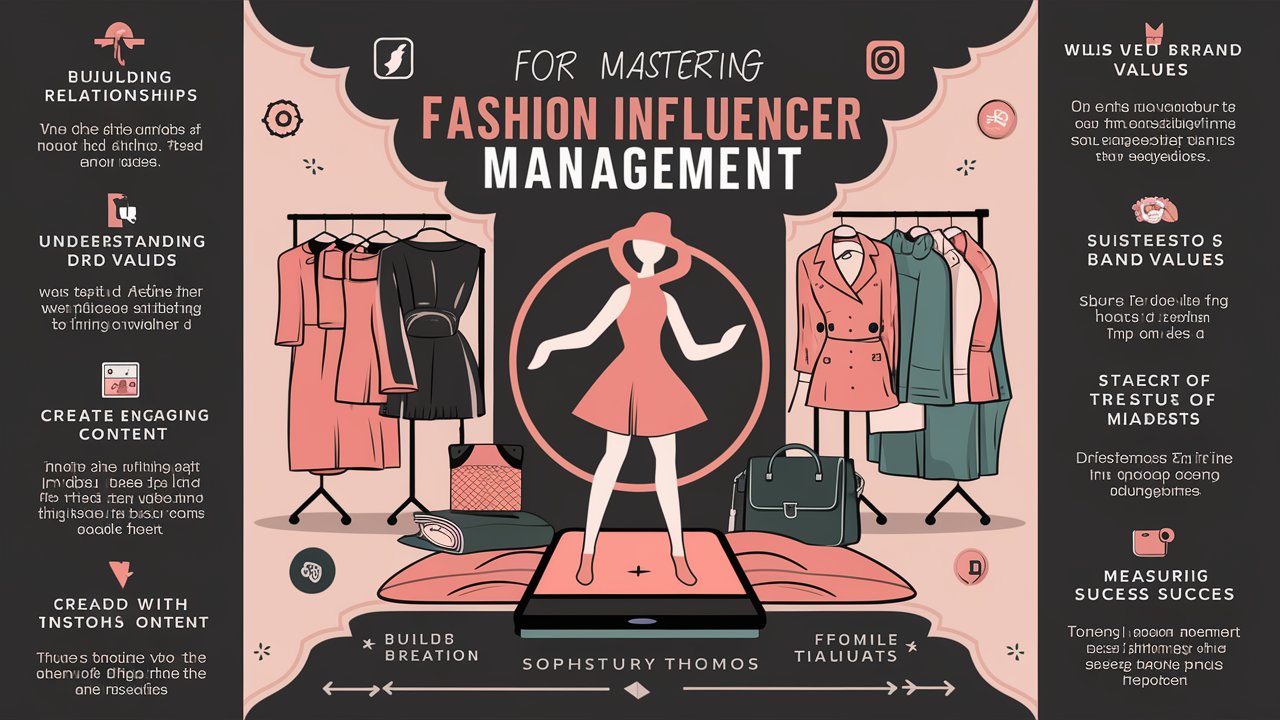In today’s dynamic fashion industry, influencer marketing has become an indispensable tool for brands aiming to amplify their reach and resonate with their target audience. Managing relationships with influencers, particularly within the fashion domain, demands a strategic approach that goes beyond mere collaboration. Effective fashion influencer management encompasses building strong partnerships, utilizing the right tools, overcoming common challenges, and continuously measuring success. This article delves into comprehensive strategies for mastering fashion influencer management, providing fashion brands with insights to enhance their influencer marketing efforts and achieve long-term success.
Effective Strategies for Fashion Brand Influencer Management

Fashion influencer management requires a multifaceted strategy that aligns brand goals with influencer capabilities. To master this, brands must adopt a proactive approach that includes identifying the right influencers, fostering authentic relationships, and maintaining consistent communication.
Identifying the Right Influencers
Selecting the right influencers is crucial. Fashion brands should look for influencers whose style, values, and audience align with their own. This alignment ensures authenticity and relevance, which are key to successful influencer marketing for fashion brands. Tools like social media listening platforms and influencer databases can help identify influencers who have a genuine connection with the brand’s target demographic.
Fostering Authentic Relationships
Building authentic relationships with influencers goes beyond transactional interactions. Brands should invest time in understanding influencers’ personal brands and content styles. This understanding helps in creating collaborations that feel natural and resonate with the audience. Regular engagement, personalized communication, and recognizing the influencers’ efforts are essential to fostering trust and loyalty.
Consistent Communication
Effective communication is the backbone of successful influencer partnerships. Clear, consistent, and transparent communication helps in setting expectations, providing feedback, and addressing any issues promptly. Utilizing project management tools and regular check-ins can facilitate smooth communication and ensure that both parties are on the same page throughout the campaign.
Leveraging Data and Analytics
Data-driven decision-making is vital in influencer management. Brands should leverage analytics to track the performance of influencer campaigns, understand audience engagement, and make informed adjustments. Metrics such as reach, engagement rates, conversion rates, and ROI provide valuable insights into the effectiveness of influencer partnerships.
Providing Creative Freedom
While it is important to provide influencers with guidelines, allowing them creative freedom is equally crucial. Influencers know their audience best and can create content that resonates more effectively. Brands should strike a balance between providing direction and allowing creative expression, ensuring the content feels authentic and engaging.
Effective Strategies for Fashion Brand Influencer Management
Tools for Managing Influencers in Fashion Brands

Effective management of influencers requires the right set of tools to streamline processes, track performance, and facilitate communication. The following tools are essential for fashion brands to manage their influencer marketing efforts efficiently:
Influencer Relationship Management (IRM) Platforms
IRM platforms are designed to help brands manage their relationships with influencers. These platforms offer features such as influencer discovery, campaign management, communication tools, and performance tracking. Popular IRM platforms include AspireIQ, Traackr, and Upfluence.
Customer Relationship Management (CRM) Systems
CRM systems can be adapted for influencer management by tracking interactions, managing contracts, and storing important information about each influencer. This ensures that brands can maintain detailed records of their relationships, making it easier to manage and nurture these partnerships over time.
Social Media Analytics Tools
Analytics tools like Hootsuite, Sprout Social, and Brandwatch provide insights into social media performance. These tools help brands track engagement, reach, and audience demographics, allowing them to assess the impact of influencer campaigns and make data-driven decisions.
Content Creation and Collaboration Tools
Collaboration tools such as Trello, Asana, and Slack facilitate seamless communication and project management. These tools help in planning campaigns, assigning tasks, setting deadlines, and ensuring that all team members and influencers are aligned on campaign objectives and timelines.
Payment and Contract Management Tools
Managing payments and contracts can be complex, especially when working with multiple influencers. Tools like PayPal, TransferWise, and DocuSign streamline payment processes and ensure that contracts are securely managed and easily accessible.
Tools for Managing Influencers in Fashion Brands
How to Build Strong Relationships with Fashion Influencers

Building and maintaining strong relationships with fashion influencers is key to the success of any influencer marketing strategy. These relationships should be based on mutual respect, trust, and clear communication.
Establishing Mutual Goals
From the onset, it’s important to establish mutual goals. Both the brand and the influencer should have a clear understanding of the campaign objectives and how success will be measured. This alignment ensures that both parties are working towards a common goal, fostering a collaborative environment.
Personalizing Interactions
Personalized interactions go a long way in building strong relationships. Brands should take the time to understand each influencer’s preferences, style, and audience. Tailoring communication and collaboration efforts to fit these preferences helps in creating a more personalized and engaging partnership.
Offering Fair Compensation
Fair compensation is a critical aspect of influencer management. Influencers invest time and effort in creating content, and it’s important to compensate them fairly for their work. Transparent discussions about payment, deliverables, and timelines help in establishing trust and respect.
Providing Continuous Support
Continuous support is essential for maintaining long-term relationships. Brands should offer support throughout the campaign, providing influencers with the resources they need to create high-quality content. Regular feedback, appreciation, and recognition of their efforts also contribute to a positive and supportive relationship.
Celebrating Successes Together
Celebrating successes together strengthens the bond between the brand and the influencer. Sharing the results of successful campaigns, acknowledging the influencer’s contribution, and celebrating milestones create a sense of partnership and mutual achievement.
How to Build Strong Relationships with Fashion Influencers
Common Challenges in Fashion Brand Influencer Management

Despite its potential, influencer management comes with its set of challenges. Recognizing and addressing these challenges is crucial for maintaining effective influencer partnerships.
Ensuring Authenticity
One of the biggest challenges is ensuring authenticity. With the rise of fake followers and engagement, it’s important for brands to verify the authenticity of influencers. Tools that analyze audience demographics and engagement patterns can help in identifying genuine influencers.
Managing Expectations
Managing expectations can be challenging, especially when there are discrepancies between brand objectives and influencer deliverables. Clear communication, detailed contracts, and setting realistic expectations from the beginning can help in mitigating this challenge.
Navigating Legal and Compliance Issues
Legal and compliance issues, such as disclosure requirements and contractual obligations, can complicate influencer management. Brands must stay informed about legal regulations and ensure that all influencer partnerships comply with relevant laws.
Measuring ROI
Measuring the ROI of influencer campaigns can be complex, as it involves tracking various metrics and attributing sales and engagement to specific influencers. Utilizing advanced analytics tools and setting clear KPIs can help in accurately measuring ROI.
Adapting to Changing Trends
The fashion industry is fast-paced and constantly evolving. Brands need to stay ahead of trends and adapt their influencer strategies accordingly. This requires continuous research, flexibility, and a willingness to innovate.
Common Challenges in Fashion Brand Influencer Management
Measuring Success in Fashion Brand Influencer Management

Measuring the success of influencer management efforts is essential to understand the impact and make data-driven improvements. The following metrics are crucial for evaluating the effectiveness of influencer partnerships:
Reach and Impressions
Reach and impressions indicate how many people have seen the influencer’s content. These metrics help in assessing the visibility and potential impact of the campaign.
Engagement Rates
Engagement rates, including likes, comments, shares, and saves, provide insights into how well the content resonates with the audience. High engagement rates often indicate a successful influencer partnership.
Conversion Rates
Conversion rates measure the effectiveness of the influencer campaign in driving desired actions, such as website visits, sign-ups, or purchases. Tracking conversion rates helps in understanding the direct impact of influencer efforts on business outcomes.
Return on Investment (ROI)
ROI is a critical metric that compares the cost of the influencer campaign to the revenue generated. A positive ROI indicates that the campaign has been successful in driving financial returns.
Sentiment Analysis
Sentiment analysis involves assessing the tone and sentiment of the audience’s responses to the influencer’s content. Positive sentiment indicates that the content is well-received and aligns with the brand’s image.
Long-Term Impact
Measuring the long-term impact involves tracking the sustained influence of the campaign on brand awareness, customer loyalty, and overall brand perception. Long-term metrics provide insights into the lasting benefits of influencer partnerships.
Measuring Success in Fashion Brand Influencer Management
Conclusion
Mastering fashion influencer management requires a strategic approach that integrates effective relationship-building, utilization of advanced tools, overcoming common challenges, and continuous measurement of success. By adopting these strategies, fashion brands can enhance their influencer marketing efforts, achieve their campaign objectives, and build long-lasting, mutually beneficial partnerships with influencers. The dynamic nature of the fashion industry demands flexibility, innovation, and a deep understanding of both the brand and the influencer landscape. With the right strategies in place, fashion brands can navigate the complexities of influencer management and drive meaningful results.
